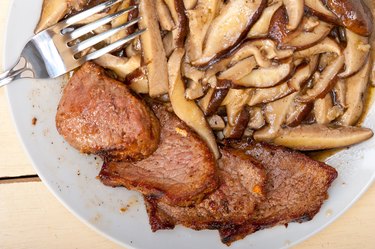
A venison backstrap is the strip of muscle that runs alongside the deer's spine, just under the skin. It's a wonderfully tender and healthy meat, and you can substitute backstrap into baked venison tenderloin recipes.
De-Game the Backstrap
Video of the Day
If you find that venison tastes "gamey" to you, the USDA recommends soaking it overnight in a solution of 1 cup vinegar to 1 quart of cold water; you can also use a solution of 1 tablespoon salt to 1 quart of cold water. Cover the backstrap completely, and discard the soaking solution in the morning.
Video of the Day
Prepare the Meat
The USDA recommends roasting your wild game at 325 degrees F; using this moderately low temperature will help keep the backstrap tender and moist while minimizing shrinkage.
While the oven heats up, trim any excess fat off your venison backstrap. Rub the meat with salt and pepper to taste; keeping the spices simple lets the flavor of the deer shine through.
Next, lay the backstrap out on a shallow pan and cover or wrap it with strips of bacon. As the USDA notes, cooking a bacon-wrapped backstrap in the oven is a way to keep the meat moist while it cooks — and of course it makes an already delicious cut of meat even better.
Cook Until Done
The USDA recommends cooking wild game to an internal temperature of 165 degrees F. Cooking a venison backstrap in the oven may take as long as 20 to 40 minutes, depending on the size and thickness of the meat.
Just as with domestic meats, cooking venison thoroughly is key for food safety — but you won't be able to tell the meat's temperature by looking at it or checking a timer. Instead, use a meat thermometer inserted into the thickest part of the backstrap.
A Venison Backstrap Marinade
You — or somebody you know — worked hard to harvest that venison, so it should be the star of the show. But if you'd like to add extra flavor or nuance, or simply enjoy the extra tenderness that comes from an acid bath, consider marinating the backstrap overnight before you cook it.
For a simple marinade recipe to bring out the flavor of your meat, take a tip from the University of Minnesota Extension and combine the following ingredients in a nonreactive container (glass, stainless steel and food-grade plastic all work well), then soak the backstrap in the marinade overnight:
- 2 tablespoons vinegar
- 1 1/2 teaspoon ground ginger
- 1 clove minced garlic
- 2 tablespoons brown sugar
- 1/2 cup soy sauce
- 3/4 cup vegetable oil
You can also repurpose any of your favorite red meat marinades to tenderize your venison backstrap, or swap in an oil and vinegar-based salad dressing. Creating your own marinade by mixing your favorite high-quality cooking oil with an acid ingredient such as lemon juice, vinegar or wine, then add fresh herbs or spices to taste.
Here's another useful suggestion about food safety and marinades: If you want to use some of your marinade as sauce on the cooked backstrap, reserve that portion of marinade before you begin soaking the meat. Once the raw meat has been in the marinade, you can't use the marinade for anything else (including dressing the cooked meat) unless it's been boiled to destroy any harmful bacteria.
Tip
Here's a great tip from FoodSafety.gov: For food safety, do your marinating in the refrigerator. That keeps the meat at a safe temperature to reduce the growth of harmful bacteria.
Read more: How to Cook Venison Ribs